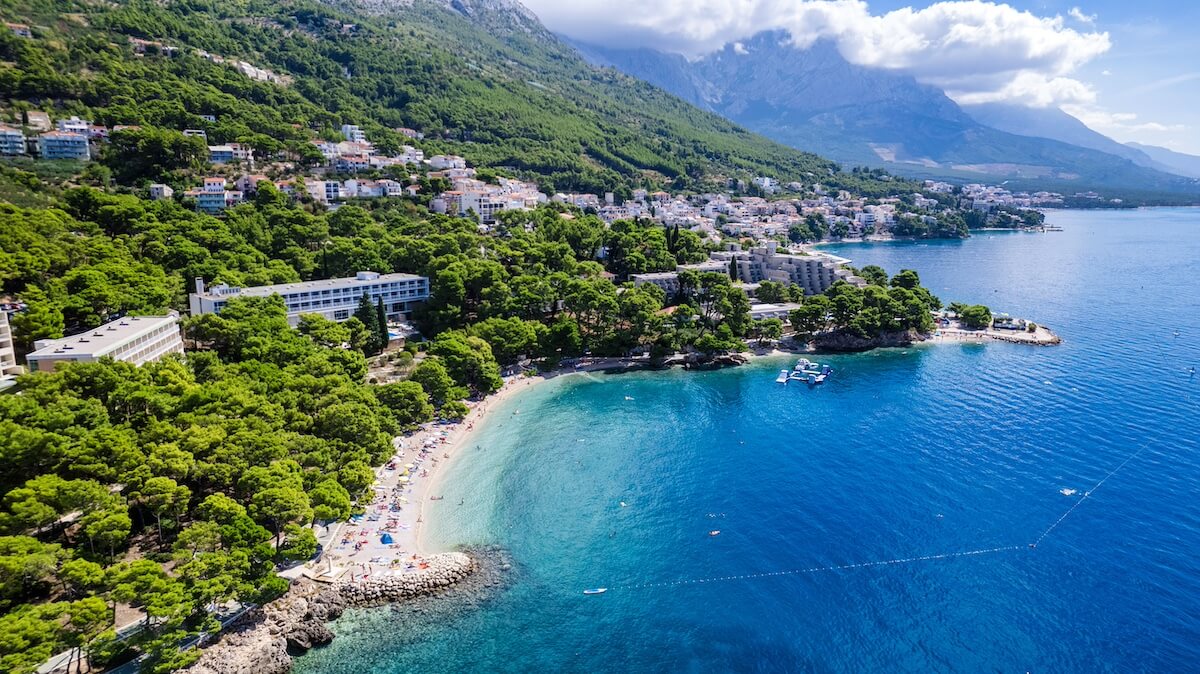Heading to Croatia this year for some summer sun?
This popular country has a vast coastline rich with historic towns, emerald bays, picturesque coves, charming fishing villages, and divine seafood.
The mainland coast is 1,777km long and boasts endless (well, over 1000) islands. Here’s a guide to help you figure out the best place for you to stay in Croatia, be it a swanky all-inclusive resort or a handy base for budget adventures.
This guide will cover:
- a shortlist of the very best hotels on the Croatian Coast
- a quick overview of Croatia’s seaside and what you need to know
- a guide to each region and its best beach resorts and hotels, including Dubrovnik, Split, Hvar, and the Istrian Peninsula
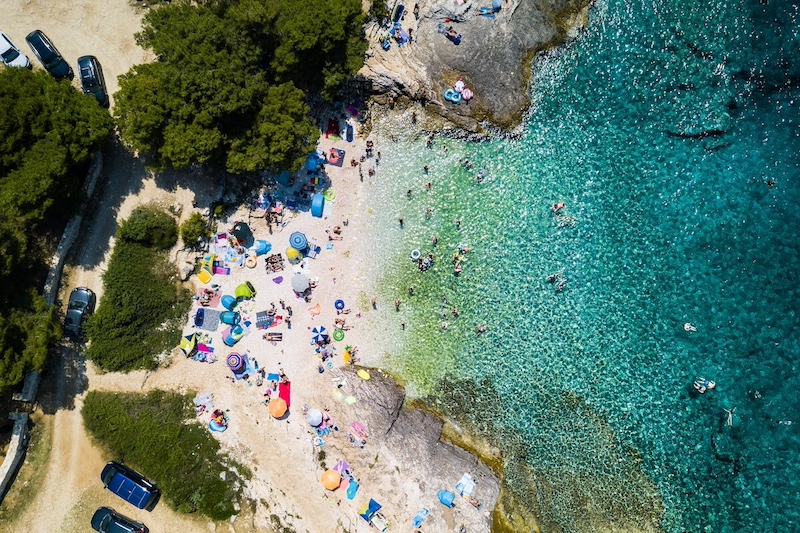
Shortlist – the Best Places to Stay in Croatia
- Best Luxury Hotels: Maslina Resort (Hvar), Hotel Lone(Rovinj), Grand Park Hotel Rovinj (Rovinj)
- Best Infinity Pool: Grand Park Hotel Rovinj(Rovinj),Villa Nai 3.3 (Dugi Otok)
- Best Beachfront Hotels: Amfora Resort (Hvar), Monte Mulini (Rovinj)
- Best Small and Charming Hotels: Hotel San Giorgio (Vis), Villa Giardino (Brač), Hotel Apoksiomen (Lošinj)
- Best Adults-Only: Hotel Lemongarden (Brač), NINON (Dubrovnik)
- Best Family Resort Hotel: Dubrovnik Sun Gardens (Dubrovnik), Maslina Resort (Hvar), Amarin Hotel (Rovinj)
- Swankiest: Villa Lopud 1483(Lopud)
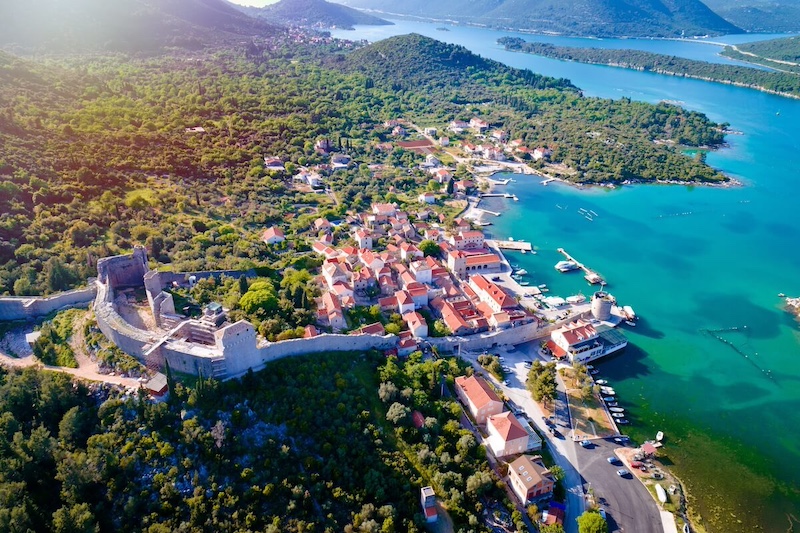
The Best Places to Go in Croatia for Every Type of Holiday
- Where to Stay for Nightlife: Hvar, Pula, Zadar, Split
- Best for Activities and Daytrips: Pula, Omiš, Zadar, Split
- Best Place for Sandy Beaches: Rab
- Best Quiet Unspoilt Places: Pelješac Peninsula, Lošinj, Cres, Vis, Šolta, Lastovo
- Where to Stay for Couples: Rovinj, Poreč, Trogir, Korčula
- Where to Stay for Nature: Mljet
- Best Place for Beachfront Hotels: Makarska
- Best All-round Beach Break: Makarska
- Best All-round Islands: Krk, Rab, Brač, Hvar
- Underrated Places: Orebić, Pelješac Peninsula, Rab, Primošten
- Best Beach Base for Dubvronik: Cavtat
- Best Beach Base for Split: Omiš
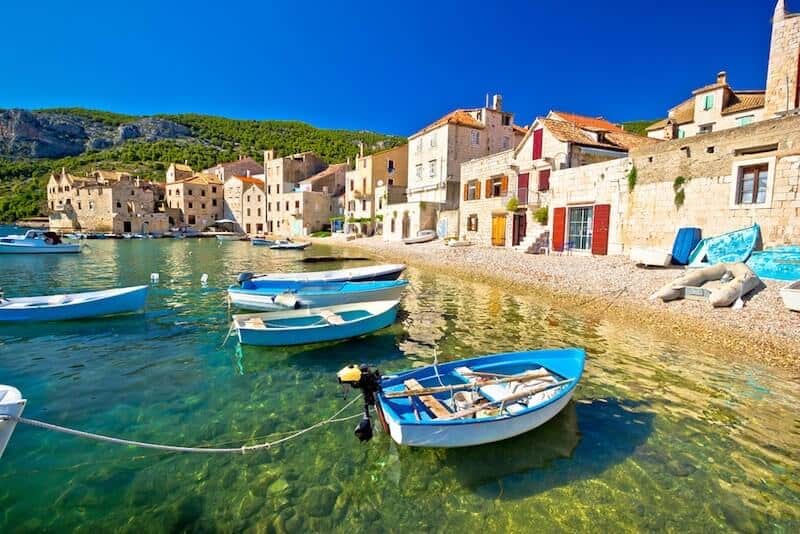
Beach Resorts in Croatia – A Quick Overview
Most visitors to Croatia come for the gorgeous harbour towns and stunning unspoiled coastal scenery of its Adriatic Coast. Croatia’s interior is much less visited, except around the popular waterfalls.
The beaches here tend to be pebbly, often with pine trees up to the shore giving everything a vibrant green and turquoise colour. There are a few areas with sandy beaches but you have to seek them out. Best to pack your sea shoes. Assume that all beaches mentioned in this guide are pebble unless otherwise noted.
Most beaches are public and family-friendly, you will find some expensive beach clubs, often with sunbathing platforms and a swanky restaurant attached.
Croatia is home to some of Europe’s most beautiful old towns. Small peninsulas are walled for protection and topped with terracotta roof tiles. Narrow alleyways provide shelter from the wind. Dubrovnik’s Old Town is the most famous example, but there are many smaller delights even down to the tiny harbour villages on the islands.
There are some big hotels and developments but, on the whole, it’s relatively unspoilt and sympathetic (compared to the Spanish coast for example) thanks to its rugged shore and the interruption of war in the ’90s.
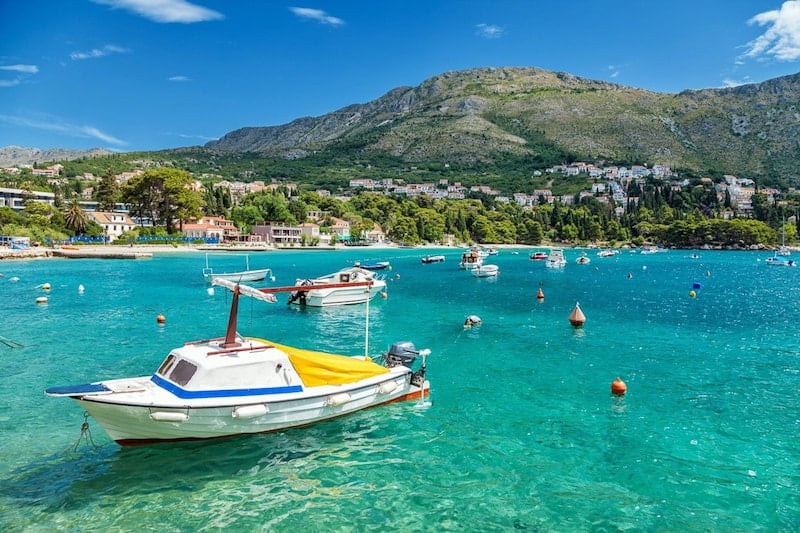
The busiest resort areas in Croatia are close to the international airports and main tourist attractions – Dubrovnik, Split, Zadar, Pula, plus the island of Hvar. These are also the best places to go for nightlife and to find high-end luxury hotels. Split and the area to its south (the Makarska Riviera) is the busiest section of coastline.
But the whole shore is popular with those visiting from inland central Europe and the Balkans by car. So even the places you haven’t heard of will likely be busy in July and August. There are many sections of the coast with great family beach resorts, traditional apartments, and campsites.
Thankfully it’s still possible to find somewhere quiet but it helps to head away from the airport areas. There’s plenty of peace to be found on the islands, even the popular ones (best to book in advance for the summer peak though). Ferry journeys are mostly short and frequent, the islands are much closer together and to the coast than the Greek islands.
I’m also a big fan of the tranquil Pelješac Peninsula which is a short drive north of Dubrovnik, it’s one of the best (and most overlooked) holiday destinations in Croatia and is particularly great for foodies.
Dubrovnik
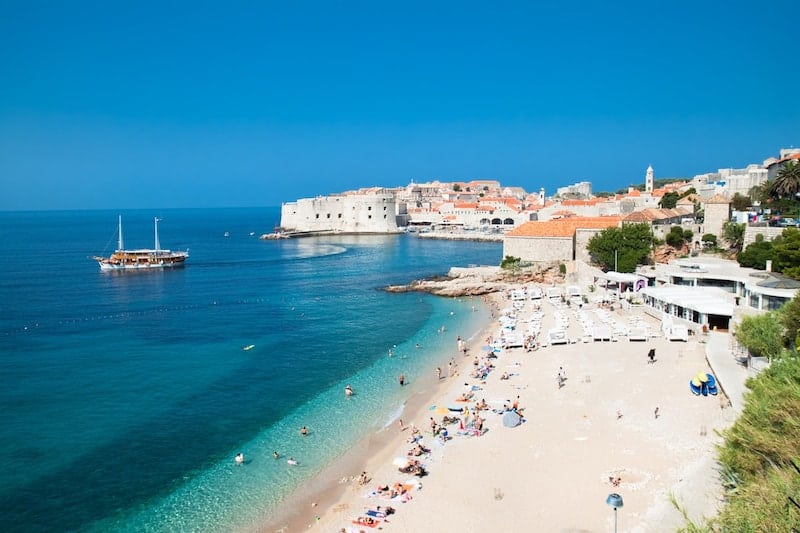
Dubrovnik is the jewel in Croatia’s tourist crown. Famous for its immaculately restored UNESCO-listed walled city and Game of Thrones filming locations, it’s one of the most popular tourist destinations in the country – particularly with cruise ship passengers.
If you haven’t been to Croatia before, there’s a good chance you’re heading to Dubrovnik first. The international airport in Dalmatia is one of the main international gateways to the coast.
The city is in the middle of the long spindly Dalmatia region (everything south of Zadar) and is a ferry hub for the Dalmatian islands.
The Old Town is understandably the focal point for visitors. It’s well-maintained and beautiful but beware of steep alleyways. There aren’t too many hotels within the Old Town but you will find apartments.
- 4-star St Joseph’s
- 4-star Boutique Hotel Stari Grad
- 5-star The Pucić Palace
- The Byron – Old Town apartment with lavish historic touches including a piano.
- 5-star Hilton Imperial Dubrovnik is located just outside the Old Town in a 19th-century building but has acres of space plus amenities such as a spa and indoor pool.
The walled old town is only a small part of the modern city (population of 42,000). There are plenty of hotels inside the Old Town and along the coast on either side. To the north is the New Port (also known as Gruž), where the ferries and cruise ships dock.
This area is nicer than it sounds – it used to be a summer retreat and still has old streets and villas. But it also has modern amenities and is well connected to the old town by bus. It’s a good bet if you’re staying a while and self-catering as it’s a lot less busy than the Old Town and you’ll find supermarkets/laundry/cafes/bars, plus a fruit and vegetable market.
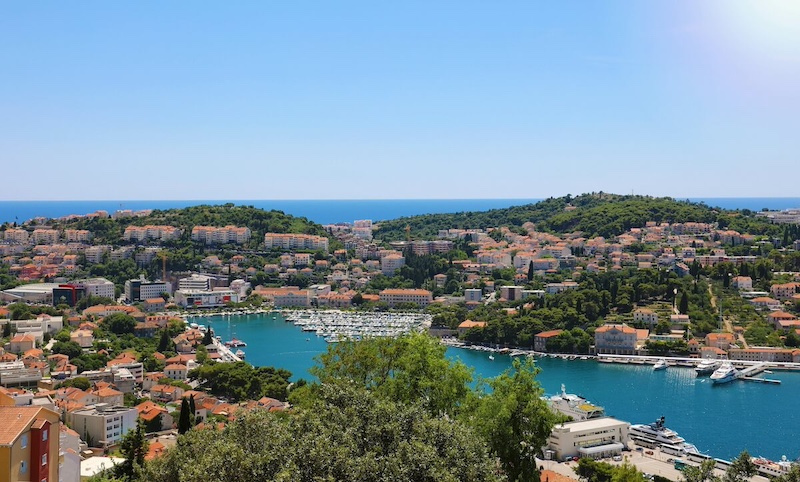
Opposite Gruž is the pine-clad Lapad Peninsula (pictured above). This area is home to many of Dubrovnik’s big 4 and 5-star resort hotels. There are a few beaches and most of the hotels have sea-view rooms. It’s a long-ish walk or a short bus ride to the Old Town.
- 5-sar Dubrovnik Palace Hotel
- 5-star Rixos Premium Dubrovnik
- 4-star Hotel Kompas
- 5-star Hotel Bellevue
- 4-star Hotel Neptun, Lapad
- 5-star Valamar Collection Dubrovnik President
- 4-star Villa Orabelle
On the south side of the old town is its most famous beach, Banje. Where else can you take a dip in the sea with such a backdrop?
It’s a small beach and wildly packed in the summer. Beyond Banje, there are a few small beaches and coves spread out along the coast. It’s an area best suited to independent explorers with a car looking for an apartment, but there are a few big luxury hotels.
- 5-star Hotel Excelsior
- 5-star Villa Dubrovnik
If you don’t mind being some distance out of town, there are two very highly rated hotels to the north of Dubrovnik:
- Radisson Blu Dubrovnik Sun Gardens – vast 5-star with a huge range of family amenities.
- NINON Dubrovnik – Adults Only – 4-star with impeccable design.

Keep going south and you’ll reach a pretty bay lined with cypress pines, small beaches, and several little resort villages – Kupari, Mlini, Soline, Plat, and Cavtat (pictured above). The first three are the best for beaches, whereas the latter is the biggest and the most well-known.
Cavtat has a harbour, a bit of buzz, and some lovely walks. Water taxis will take you to Dubrovnik and back (buses are also available). It’s only a few km from the airport so an ideal destination for a short sunny break with access to the city. There’s a good selection of resort hotels and many package tour operators offer holidays to hotels in this area.
- 5-star Sheraton Dubrovnik Riviera (Mlini)
- 5-star Hotel Supertar (Cavtat)
- 4-star Hotel Seventh (Cavtat)
- 5-star Hotel Croatia (Cavtat)
- 4-star Maistra Select (Mlini)
- 4 star Maistra Select Srebreno Villas (Mlini)
South of Cavtat the coast is steep and quiet all the way to Montenegro.
Islands Near Dubrovnik

The closest island to Dubrovnik is Lokrum but it’s for daytrippers, there are no hotels. But do take the quick boat ride over from the Old Port to say hello to its resident peacocks!
Next up are the three Elafiti Islands – Koločep, Lopud, and Sipan. These three are within day trip (and excursion boat) distance but also make a great base for a relaxed break enjoying the beaches and walking trails. The tourism here is relatively low-key. Lopud and Koločep are both car-free.
- Villa Lopud 1483 is a stunning restored monastery available for private rental.
- Beachfront 4-star Lafodia Sea Resort is the only big resort hotel in the Elafiti Islands, on car-free Lopud.
- Charming 4-star Hotel Bozica has a harbour location in Suđurađ, Sipan, with a sea view pool.
- All-inclusive 4-star TUI Blue Kalamota Island has a small pool right by the beach (pictured above).

Outside the Elafiti is Mljet, easily one of the most beautiful islands in Croatia. It’s a protected national park and superbly green and untouched. There are no cars on the island, instead, visitors get around by bike and boat.
- 3-star Hotel Odisej Mljet is a peaceful 3-star with a beach bar.
- PineTree Boutique Apartments share a lovely infinity pool.
Pelješac Peninsula

Look at its geography and the Pelješac Peninsula could almost be a long spindly island right next to the mainland. There’s just a small bit of land at Mali Ston adjoining them.
Mali Ston is famous for its oysters and its wall, there are lots of vineyards, and the whole area is a treat for foodies. You’ll need a car to make the most of it.
At the other end of the peninsula is pretty Orebić where you’ll find ferries to Korcula.
- Heritage Boutique Hotel Adriatic (adults-only) is right on the narrow beach.
- Aminess Grand Azur Hotel is a family-friendly beachfront 4-star resort hotel.
- Aminess Bellevue is a tranquil 4-star right by a small shaded beach.
The drive north to Split has long been complicated by a section of coast belonging to Bosnia and Herzegovina, but that was solved recently by the construction of a bridge connecting Pelješac with the mainland.
Ferries to Mljet leave from the south of the peninsula.
Halfway between Dubrovnik and Split is Korčula, Croatia’s wine island. It has a small walled old town like a miniature Dubrovnik. You can rent bicycles right off the ferry and whizz away to explore the vineyards. It’s one of the best places in Croatia for couples thanks to the romance of Korčula Town.
- 4-star Aminess Korcula Heritage Hotel is a smart townhouse hotel inside the old town.
- 5-star Lesic Dimitri Palace has the most beautiful apartments in the old town, with a spa available too.
- 4-star The Fabris Luxury Inn has atmospheric rooms just outside the old town.
- Tara’s Lodge is a popular 4-star a short walk west of Korčula Town with a small beach.
Split

Split is Croatia’s second most popular destination, but it’s a much bigger city than Dubrovnik – the population is around 176,000. The overall vibe is youthful and vibrant.
The old town sits directly behind the palm-lined promenade (known as Riva) and developed around the summer palace of the Roman Emperor Diocletian. The building is woven uniquely into the fabric of the city.
Split isn’t walled or built on a peninsula like so many in Croatia, but the old quarter here is just as atmospheric. The promenade encloses a large upside-down U-shaped harbour, with its modern port on the east side and a marina on the west.
Split is the most important travel hub in the country so is an excellent starting point for onward travel or a base for short excursions. The airport is a 1hr drive west of the city (much nearer to Trogir if you’re looking for an easy short break destination).
Beautiful Old Town boutiques include:
Just outside the old town, 5-star Hotel Ambassador has impeccable views of the harbourfront from its pool.

Split’s most popular beach – Bacvice – is just east of the new port. It’s small and busy but the place to see and be seen. If you keep heading east there are a few more small beaches and a marina.
- Modern and stylish 4-star Briig Boutique is right by Bačvice Beach.
To the west of the city is the forested Marjan Park. It’s worth the extra steps to reach Kasjuni Beach (pictured above).
South of Split are some coastal suburbs which have become defacto tourist resorts due to their proximity to the city – Podstrana has a decent beach. 5-star Hilton Le Meridien Lav is right on the beach.
There’s a nice beach at Duće. But if you’re not looking to stay in Split itself then it’s worth continuing south to Omiš (pictured below) which has a large beach and is a haven for adventure sports enthusiasts. 4-star Hotel Plaza has modern amenities right by the sea.
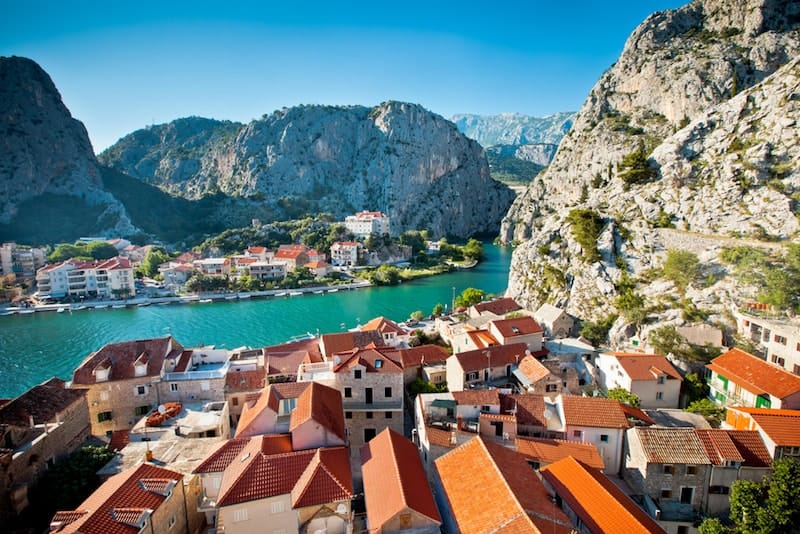
North of Split is the gorgeous town of Trogir, a great destination in its own right or a day trip from Split. There are plenty of great pebble beaches around Trogir, such as Bučevica and Kava.
- Stylish 4-star Hotel Brown Beach House & Spa is located at the edge of town and has a seafront swimming pool.
- 4-star Hotel Ola (adults only) is a outside Trogir but has great views across to town from its pool.
Read more – A Quick Guide to Split
Makarska Riviera
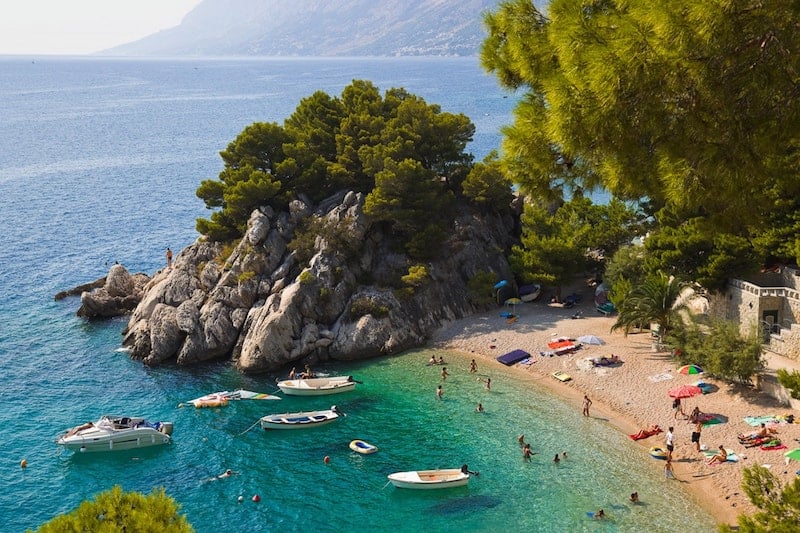
The Makarska Riviera is the name given to the coastline between Brela and Grada, with popular Makarska sitting in the middle. It’s a stunning bit of coast, with a long line of small beach resorts sitting at the foot of the steep karst Biokovo mountains, the tops of which are often shrouded in cloud.
It has all the trappings needed for a relaxing beach break (or one filled with healthy activity). No wonder the area has long been popular with package tour operators.
Most of the historic buildings are up in the mountains rather than down by the sea, but what it lacks in old stuff it makes up for with reliable stretches of pebble beach and dazzling scenery. The hiking is fantastic, although Biokovo Mountain itself is best left to experienced hikers.
Brela is one of the most well-known spots thanks to its pretty beach Punta Rata (pictured above).
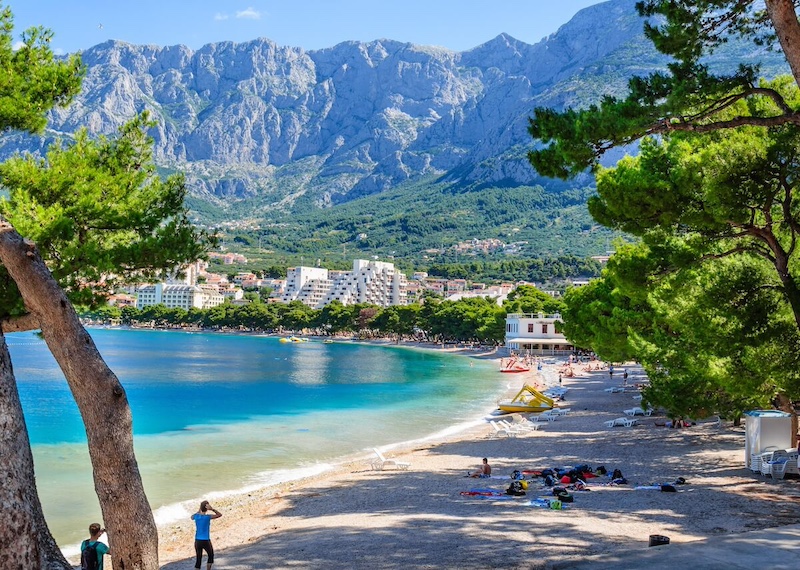
Makarska is the biggest and liveliest town. It has an old town and a promenade but the main beach is just outside town. Nearby is Nugal, one of the most beautiful beaches in Croatia.
A main road runs from Split right down through the Riviera so it’s easy to explore by bus. It’s over an hour to Split depending on traffic. Expect numbers to swell at weekends with locals escaping the city.
There are many simple rooms, apartments, and campsites available, but you’ll also find many big resort hotels right on the seafront:
- 4-star Hotel Central Beach(Makarska)
- 4-star Hotel Osejava (Makarska)
- 4-star Valamar Meteor (Makarska)
Islands Near Split

Hvar is Croatia’s most famous island, known for its beautiful medieval towns and cosmopolitan nightlife. Over the past few decades, it has firmly placed itself on the map as a glam destination for the international jet set.
But you don’t need to be rich to party here, there are plenty of backpackers too. And it’s a popular stop for boat trippers (excursion boats, yachts, small cruise ships – you name it, they sail here). Don’t miss a boat trip to the Paklinski Islands.
Hvar Town and Stari Grad are the busiest spots but step away from the towns to find lavender fields and pretty villages all around the island.
- 5-star Maslina Resort is secluded and contemporary, just around the coast from Stari Grad.
- 4-star Riva Hvar Yacht Harbour in the old town has a waterfront location and modern design.
- 4-star Heritage Hotel Park Hvar is in a beautiful old building with pale pink rooms and an old town location.
- 4-star Amfora Hvar Grand Beach Resort has beach access and a beach club and is a short walk from Hvar Town.
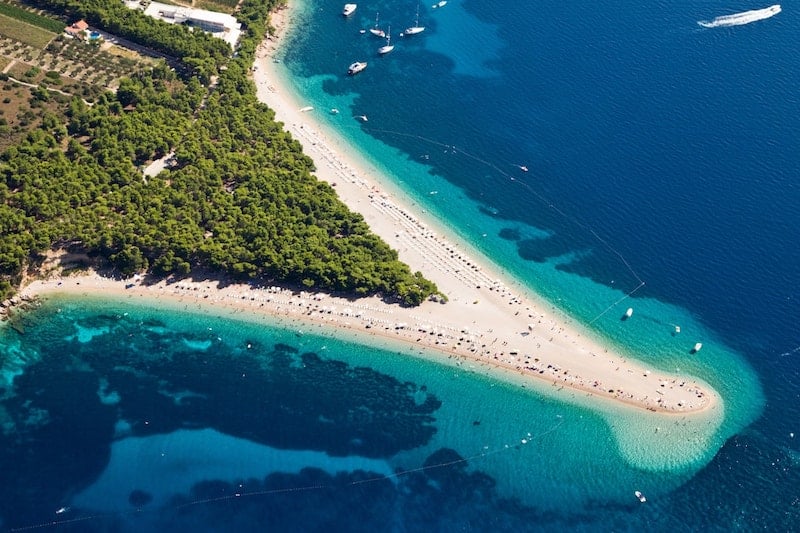
Brač is the nearest big island to Split. It’s a versatile island with plenty of attractions so is unsurprisingly busy. The ferry takes just 25 minutes from the mainland.
The vibe here not fancy like Hvar, but harbour towns like Supetar and Bol are just as photogenic. It has an excellent range of activities and plenty of hearty food. The scenery here, and in all of the islands northwards, is less green than to the south.
Brač is home to Zlatni Rat, Croatia’s most famous beach (pictured above). Although it may look sandy in pictures, this is still a pebble beach. It’s still a stunner, although crazy busy in the summer.
There are some wonderful small hotels in Brač:
Got the kids in tow? BRETANIDE Sport & Wellness is an all-inclusive 4-star right by a beach not far from Bol.
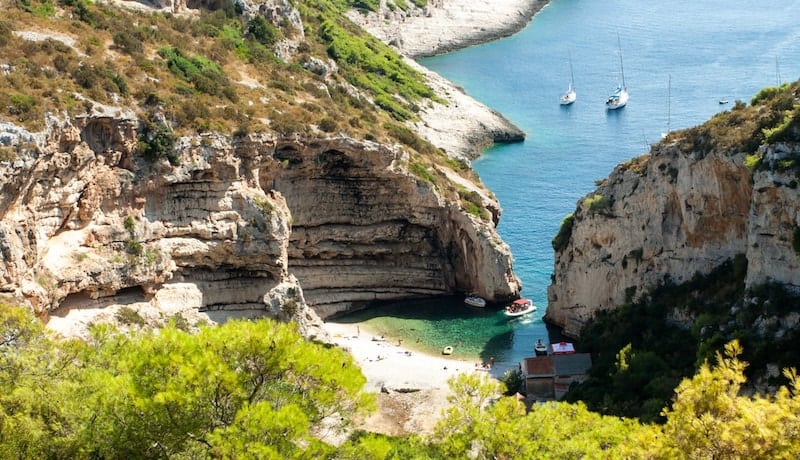
Vis is a little further away, it takes around 3 hours on the ferry. Best known as the filming location for Mamma Mia 2, Vis thankfully hasn’t succumbed to its fame and retains its rustic appeal. Don’t miss a trip to Stiniva, a stunning cove beach.
Hotel San Giorgio in Vis Town is small and charming hotel with a lovely walled courtyard.
Even quieter? Check out Biševo and Šolta.
It’s also possible to take the ferry to Korčula from Split.
Zadar

Zadar is a small coastal city with a scenic old town but it doesn’t draw the same crowds that Split and Dubrovnik do – which is reason enough to go there in the summer. It’s still lively and youthful and packs plenty of tourism punches (including its famous sea organ installation). Kolovare is the town beach, or you can head further afield to Nin’s Lagoon or Zaton. The waterfalls at Krka and the islands of the Kornati National Park are easy to visit from Zadar.
Stylish hotels in the old town include:
Falkensteiner Hotel & Spa Iadera is the top beach resort hotel in the area, with great sports facilities and spa, but is some way out of town. A closer option is DUNATOVI DVORI Heritage Hotel, a sleek small boutique located on the island of Ugljan directly opposite Zadar.
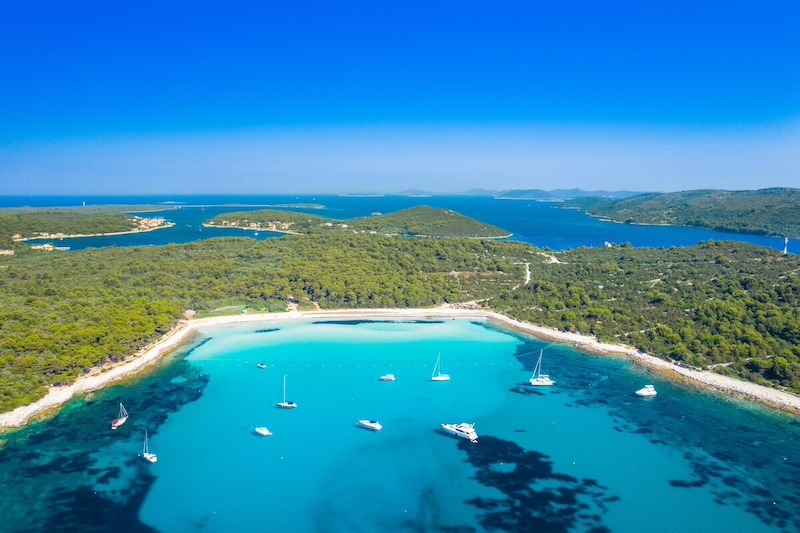
Dugi Otok is one of the biggest (and longest) islands near Zadar and you’ll find some natural wonders here including the spectacular sandy Saharun beach. Accommodation is mostly in apartments.
Villa Nai 3.3 is an exceptional luxury hotel up in the hills with a minimalist aesthetic and rooms built into the landscape.
The other main island around Zadar is Pag. People (mostly local and European youngsters) come to Pag to party on Zrće Beach in Novalja. Most of the island is rural and known for its cheese and lace-making.
If you need a comfortable place to recover, Hotel In Excelsis is a 4-star resort hotel in Novalja.

Just over an hour south of Zadar are Šibenik and Primosten, two underrated coastal towns with beautiful old quarters. Šibenik is a busy port town and has more upmarket places to stay, Primosten is smaller and much better for beaches. There’s also a small harbour at nearby Vodice.
- Life Palace Heritage Hotel Šibenik – cosy historic vibes in the old town.
- D-Resort Šibenik – shiny modern 4-star with spa right next to the marina.
Obonjan Island Resort is a private island with a boho vibe aimed squarely at the festival crowd. Amazing idea but reviews are mixed.
Kvarner Gulf
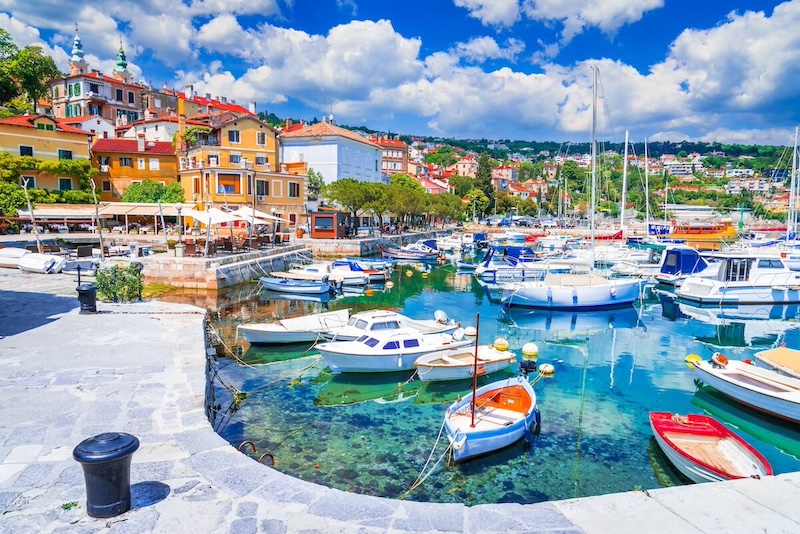
The region north of Zadar and enclosing the rest of the islands is known as the Kvarner Gulf. It has a long history of tourism thanks to its proximity to Central Europe, especially around the spa towns of Opatija and Lovran with their colourful Belle Epoque villas.
The area around here is known as the Opatija Riviera and it was the country’s equivalent of the French Riviera in the nineteenth century. These days it mainly attracts an older crowd as well as locals as it’s easily accessible from Rijeka on the train. The area is known for excellent restaurants and wellness hotels.
Standout hotels are:
- 5-star Ikador Luxury Boutique Hotel & Spa
- 5-star Amadria Park Hotel Milenij
- 5-star Hotel Bevanda
- 5-star Boutique & Design Hotel Navis

Rijeka is the biggest city in the region. It’s an industrial port town with a large student population. It’s not a big tourist destination but there’s an airport here which is starting to appear on budget airline maps so for some it can make a convenient gateway to the northern islands or Istria. The airport is actually located on the nearby island Krk, which is connected to the mainland by a bridge.
Krk is the biggest and most developed of the Kvarner islands, with a few popular resort towns like Malinksa and Omišalj. There’s a package tourism presence here (there’s a tourist train), but the vibe is still low-key and traditional. There are plenty of pebble beaches and Krk is excellent for boat trips and walking.
- 5-star Luxury Hotel Riva (Malinska)
- 4-star Hotel Vila Rova (Malinska)
The other major islands in the Kvarner Gulf are Cres, Lošinj, and Rab.

Although not as well-known internationally as Hvar and Korcula, Rab surely gives them a run for their money. And crucially, if you like sandy beaches then Rab is the island for you. Lopar and Banjol are the main resort areas. The latter is a short distance from the handsome and lively Rab Town. The island has plenty of activities and nature spots to explore, such as the Geopark.
Sahara Beach (pictured above) is one of the best sandy beaches in Croatia but you can’t drive there, you can only reach it by boat or on foot.
- Luxury Suites Bellevue – 4-star modern rooms near Lopar.
- Imperial Valamar Hotel – 4-star resort hotel overlooking Rab Town, free beach shuttle to Padova available.
- Imperial Valamar Padova – 4-star right on Padova Beach.
Cres and Lošinj are two islands (which are really two halves of the same island, separated by a small channel) connected by road. Lošinj is the smaller and more developed of the two. Picturesque pastel-hued harbours Mali Lošinj and Veli Lošinj are the most popular places to visit. Cres Town is also a delight. Accommodation on Cres is traditional and low-key.
Over on Lošinj, Hotel Apoksiomen has classic Mediterranean harbour vibes, plus there are a few resort hotels in beautiful locations:
- 5-star Hotel Alhambra (Mali Lošinj)
- 4-star Vitality Hotel Punta (Veli Lošinj)
It can help to have a car in most of the Kvarner Gulf.
Istrian Peninsula

Once a sleepy region off the tourist radar, Istria has seen an influx of visitors over the past few decades. It has a reputation as Croatia’s answer to Tuscany – think rolling hills topped medieval villages, excellent food and wine, and colourful Italianate harbour towns.
It’s easily accessed via international airports in Pula, Rijeka or over the border in Trieste. It’s also possible to take a ferry to/from Venice.

Pula is a lively city which is an excellent base for exploring the region. The old town isn’t a patch on some of the smaller coastal towns in the area, but it has an impressive Roman amphitheatre built in 1AD – one of the best preserved outside Italy.
There are some nice pebble beaches a bus ride away such as Ambrela and Hawaii Beach, but don’t miss exploring Pula’s rugged coastline by kayak, SUP, or on a boat trip.
Pula is also a good spot for nightlife – Croatia’s now legendary summer music festival scene really took off here with Outlook. The festivals are now spread out around the country, but if you enjoy adventure activities and electronic music then Pula is still a great destination.
The better hotel options tend to be outside the historic centre:
- Grand Hotel Brioni Pula – A Radisson Collection Hotel is located in a lush green area outside the centre and near the main marina.
- Boutique Hotel Valsabbion
- Park Plaza Histria Pula
Those looking for a more genteel trip tend to spread out around the coast. Upmarket harbour towns Rovinj and Poreč are the main honeypots. During the summer fast ferries connect both towns with Pula, Piran (Slovenia), and Trieste (Italy).
For those looking to get off the beaten track, there are endless pleasant seaside villages such as Novigrad, but the real treasures are found inland in villages like Motovun.

Few will come to Istria and not visit Rovinj, one of the most beautiful towns in Croatia. Its handsome old town is surrounded by a rocky coastline with small pebble beaches, mainly in the Zlatni Rt natural park. The nearest beach to town is Mullini, south of the marina.
Rovinj has plenty of smart town hotels, pick of the bunch are:
- Hotel Adriatic by Maistra Collection – town location and Rovinj’s oldest hotel (dates back to 1892), given a sleek makeover.
- Spirito Santo Palazzo Storico – beautiful boutique townhouse in the old town
- The Melegran – cool and colourful boutique vibes.
The wiggly coastline surrounding Rovinj is home to some of the best resort hotels in Croatia:
- Hotel Lone by Maistra Collection – if you’re a fan of cruising check out this contemporary 5-star design hotel based on a ship and set in its own bay, a 20-minute walk from Rovinj. It has excellent pools, a spa, activities in nature, and healthy dining options.
- Grand Park Hotel Rovinj by Maistra Collection – modern 5-star hotel with marina location, spa, and superb view of the old town and sunset from its pool.
- Monte Mulini by Maistra Collection – adults-only 5-star right on Mulini Beach.
- Maistra Select Family Hotel Amarin – family-friendly 4-star with direct access to a generous beach.
If you fancy the idea of having a practically private island here are also a few hotels on the tiny islands near to Rovinj:
North of Rovinj is the beautiful Lim Valley, a protected area. There are lots of campsites around and it’s a great spot for tranquil watersports.

Poreč is similar to Rovinj, perhaps not as glitzy or as crazy busy. You’ll find small family-run guesthouses and hotels in the old town, and a few resort hotels outside. The nearest beach is on Sveti Nicola, a small island directly opposite the old town.
- Valamar Riviera – comfortable 4-star town hotel with free shuttle boats to Sveti Nicola.
- TUI / Isabella Valamar Collection Island Resort – the only hotel on Sveti Nikola
The smaller resorts tend to be down near Zelena Laguna where there’s a small man-made sandy beach and lots of quiet pebble coves.
Wine buff? There are numerous wine hotels in the area, most a short drive from the sea:
- Relais and Wine San Tomas (Bale)
- Roxanich Winery & Design Hotel (Motovun)
- Meneghetti Wine Relais & Chateaux (Bale)
Read more:
10 Most Beautiful Islands in Croatia
10 Most Beautiful Beaches in Croatia
Where to Stay in Montenegro: Ultimate Beach Resort Guide
Enjoyed this post? Follow us on Facebook or Twitter.
Image credits:
Banksa Voda, Makarska: © Sebastian / Adobe Stock
Small beach in Istria: © vskrinjaric / Adobe Stock
Mali Ston: © xbrchx / Adobe Stock
Vis: © xbrchx / Shutterstock
Mlini: © and.one / Adobe Stock
Banje, Dubrovnik: © Aleksandar Todorovic / Adobe Stock
Lapad, Dubvrovnik: © zigres / Adobe Stock
Cavtat: © xbrchx / Adobe Stock
Kolocep: © CK Travels / Adobe Stock
Mljet: © By novak.elcic / Shutterstock
Peljesac: © Irina Sen / Adobe Stock
Split: © GISTEL / Adobe Stock
Kasjuni, Split: © Sandy / Adobe Stock
Omis: © alexdrim / Adobe Stock
Brela: © Nikolai Sorokin / Adobe Stock
Makarska: © a_mikhail / Adobe Stofk
Hvar: © Rostislav Sedlacek / Adobe Stock
Zlatni Rat: © SimoneSimone / Adobe Stock
Stiniva, Vis: © nagydodo
Zadar: © Alexey Fedorenko
Sakurun Beach: © ilijaa / Adobe Stock
Šibenik: © Alexey Fedorenko / Shutterstock
Opatija: © ecstk22/ Adobe Stock
Rijeka: © Amedee / Adobe Stock
Sahara Beach, Rab: © Michal / Adobe Stock
Rovinj: © Martin M303 / Shutterstock
Pula: © Alexey Fedorenko / Adobe Stock
Rovinj aerial: © xbrchx / Adobe Stock
Poreč: © Tilo Grellmann / Adobe Stock

